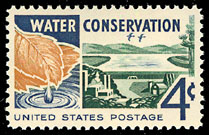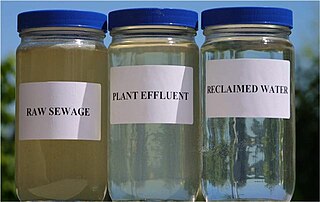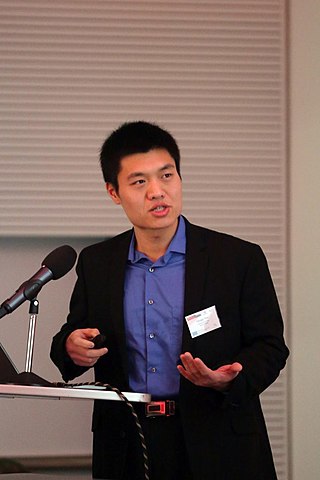Related Research Articles

Greywater refers to domestic wastewater generated in households or office buildings from streams without fecal contamination, i.e., all streams except for the wastewater from toilets. Sources of greywater include sinks, showers, baths, washing machines or dishwashers. As greywater contains fewer pathogens than blackwater, it is generally safer to handle and easier to treat and reuse onsite for toilet flushing, landscape or crop irrigation, and other non-potable uses. Greywater may still have some pathogen content from laundering soiled clothing or cleaning the anal area in the shower or bath.

Water conservation includes all the policies, strategies and activities to sustainably manage the natural resource of fresh water, to protect the hydrosphere, and to meet the current and future human demand. Population, household size and growth and affluence all affect how much water is used. Factors such as climate change have increased pressures on natural water resources especially in manufacturing and agricultural irrigation. Many countries have already implemented policies aimed at water conservation, with much success. The key activities to conserve water are as follows: any beneficial reduction in water loss, use and waste of resources, avoiding any damage to water quality; and improving water management practices that reduce the use or enhance the beneficial use of water. Technology solutions exist for households, commercial and agricultural applications. Water conservation programs involved in social solutions are typically initiated at the local level, by either municipal water utilities or regional governments.
Alternative technology is a term used to refer to technologies that are more environmentally friendly than the functionally equivalent technologies dominant in current practice. The term was coined by Peter Harper, one of the founders of the Centre for Alternative Technology, North Wales, in Undercurrents (magazine) in the 1970s. Alternative Technologies are created to be safer, cleaner, and overall more efficient. The goals of alternative technology are to decrease demand for critical elements by ensuring a secure supply of technology that is environmentally friendly, increased efficiency with lower costs, and with more common materials to avoid potential future materials crises. Alternative technologies use renewable energy sources such as solar power and wind energy. Some alternative technologies have in the past or may in the future become widely adopted, after which they might no longer be considered "alternative." For example, the use of wind turbines to produce electricity.

Water reclamation is the process of converting municipal wastewater (sewage) or industrial wastewater into water that can be reused for a variety of purposes. Types of reuse include: urban reuse, agricultural reuse (irrigation), environmental reuse, industrial reuse, planned potable reuse, de facto wastewater reuse. For example, reuse may include irrigation of gardens and agricultural fields or replenishing surface water and groundwater. Reused water may also be directed toward fulfilling certain needs in residences, businesses, and industry, and could even be treated to reach drinking water standards. The injection of reclaimed water into the water supply distribution system is known as direct potable reuse, however, drinking reclaimed water is not a typical practice. Treated municipal wastewater reuse for irrigation is a long-established practice, especially in arid countries. Reusing wastewater as part of sustainable water management allows water to remain as an alternative water source for human activities. This can reduce scarcity and alleviate pressures on groundwater and other natural water bodies.

Zero waste is a set of principles focused on waste prevention that encourages redesigning resource life cycles so that all products are repurposed and/or reused. The goal of the movement is to avoid sending trash to landfills, incinerators, oceans, or any other part of the environment. Currently 9% of global plastic is recycled. In a zero waste system, all materials are reused until the optimum level of consumption is reached.

Green building refers to both a structure and the application of processes that are environmentally responsible and resource-efficient throughout a building's life-cycle: from planning to design, construction, operation, maintenance, renovation, and demolition. This requires close cooperation of the contractor, the architects, the engineers, and the client at all project stages. The Green Building practice expands and complements the classical building design concerns of economy, utility, durability, and comfort. Green building also refers to saving resources to the maximum extent, including energy saving, land saving, water saving, material saving, etc., during the whole life cycle of the building, protecting the environment and reducing pollution, providing people with healthy, comfortable and efficient use of space, and being in harmony with nature Buildings that live in harmony. Green building technology focuses on low consumption, high efficiency, economy, environmental protection, integration and optimization.’

Sydney Water, formally, Sydney Water Corporation, is a New South Wales Government–owned statutory corporation that provides potable drinking water, wastewater and some stormwater services to Greater Metropolitan Sydney, the Illawarra and the Blue Mountains regions, in the Australian state of New South Wales.

Biodegradable waste includes any organic matter in waste which can be broken down into carbon dioxide, water, methane, compost, humus, and simple organic molecules by micro-organisms and other living things by composting, aerobic digestion, anaerobic digestion or similar processes. It mainly includes kitchen waste, ash, soil, dung and other plant matter. In waste management, it also includes some inorganic materials which can be decomposed by bacteria. Such materials include gypsum and its products such as plasterboard and other simple sulfates which can be decomposed by sulfate reducing bacteria to yield hydrogen sulfide in anaerobic land-fill conditions.

Food loss and waste is food that is not eaten. The causes of food waste or loss are numerous and occur throughout the food system, during production, processing, distribution, retail and food service sales, and consumption. Overall, about one-third of the world's food is thrown away. A 2021 meta-analysis that did not include food lost during production, by the United Nations Environment Programme found that food waste was a challenge in all countries at all levels of economic development. The analysis estimated that global food waste was 931 million tonnes of food waste across three sectors: 61 percent from households, 26 percent from food service and 13 percent from retail.

Water heat recycling is the use of a heat exchanger to recover energy and reuse heat from drain water from various activities such as dish-washing, clothes washing and especially showers. The technology is used to reduce primary energy consumption for water heating.
Recycling in the Netherlands is under the responsibility of local authorities. Different localities implement different systems. Municipalities all over the country publish a calendar, on a yearly basis, of the pickup dates and the addresses of the waste separation and recycling stations.
The Folkewall is a construction with the dual functions of growing plants and purifying greywater. It was designed by Folke Günther in Sweden.

Waste are unwanted or unusable materials. Waste is any substance discarded after primary use, or is worthless, defective and of no use. A by-product, by contrast is a joint product of relatively minor economic value. A waste product may become a by-product, joint product or resource through an invention that raises a waste product's value above zero.

A circular economy is a model of production and consumption, which involves sharing, leasing, reusing, repairing, refurbishing and recycling existing materials and products for as long as possible. CE aims to tackle global challenges such as climate change, biodiversity loss, waste, and pollution by emphasizing the design-based implementation of the three base principles of the model. The three principles required for the transformation to a circular economy are: designing out waste and pollution, keeping products and materials in use, and regenerating natural systems." CE is defined in contradistinction to the traditional linear economy. The idea and concepts of circular economy (CE) have been studied extensively in academia, business, and government over the past ten years. CE has been gaining popularity because it helps to minimize emissions and consumption of raw materials, open up new market prospects and, principally, increase the sustainability of consumption and improve resource efficiency.

Bio Pac, Inc. is an American company that sells cleaning products in bulk and refillable containers. Founded in 1991, Bio Pac is 100% family owned and based in Incline Village, NV.
Resource recovery is using wastes as an input material to create valuable products as new outputs. The aim is to reduce the amount of waste generated, thereby reducing the need for landfill space, and optimising the values created from waste. Resource recovery delays the need to use raw materials in the manufacturing process. Materials found in municipal solid waste, construction and demolition waste, commercial waste and industrial wastes can be used to recover resources for the manufacturing of new materials and products. Plastic, paper, aluminium, glass and metal are examples of where value can be found in waste.

Cotton recycling is the process of converting cotton fabric into fibers that can be reused into other textile products.

The San Diego Climate Action Plan was adopted by the city of San Diego in December 2015. It is a local climate action plan whose rules are defined by the California global warming Solutions Act of 2006, with the goal of reducing greenhouse gas emissions. Through this plan, the city initially set goals of eliminating half of all greenhouse emissions and sourcing all energy from renewable sources by the year 2035. With a coalition of business owners, environmental advocates, and community leaders, Mayor Kevin Faulconer approved the Climate Action Plan. The Climate Action Plan consists of several policies to ensure the economic and environmental growth of the city of San Diego. It was referred to in The San Diego Union-Tribune as "the most aggressive climate action plan in California."

Fengqi You is a professor and holds the Roxanne E. and Michael J. Zak Chair at Cornell University in the United States. His research focuses on systems engineering and data science. According to Google Scholar, his h-index is 78.

JA21 is a political party in the Netherlands, active in the House of Representatives and Senate. It was founded on 18 December 2020 by Joost Eerdmans and Annabel Nanninga after they left the Forum for Democracy (FVD) on 26 November 2020. The party, affiliated with conservative liberalism, first participated in elections in the 15–17 March 2021 general election.
References
- ↑ "archive.ph". archive.ph. Retrieved 2023-02-24.
- ↑ Pascual, Jara (2020-11-25). "PODCAST Sabine Stuiver on Entrepreneurship and Driving Innovation into the Market". Collabwith. Retrieved 2023-02-24.
- ↑ Ven, Liam van de (2022-08-28). "Hoe de mediamagnaat een waterzuiveringssysteem in zijn garage ontwierp". de Volkskrant (in Dutch). Retrieved 2022-11-25.
- ↑ "Nederlandse vinding Hydraloop in de lift na succes op techbeurs CES". RTL Nieuws (in Dutch). 2022-01-05. Retrieved 2022-11-25.
- ↑ "US investment round for Hydraloop to relieve water-stressed regions | Dutch Water Sector". www.dutchwatersector.com. Retrieved 2022-11-25.
- ↑ "'Ik bedacht: misschien moet ik het zelf maar doen'". FD.nl (in Dutch). Retrieved 2023-02-24.
- ↑ Ven, Liam van de (2022-08-28). "Hoe de mediamagnaat een waterzuiveringssysteem in zijn garage ontwierp". de Volkskrant (in Dutch). Retrieved 2023-02-24.
- ↑ "10 news stories that stood out in 2020 | Dutch Water Sector". www.dutchwatersector.com. Retrieved 2023-02-24.
- ↑ Hobma, Jelmer (2020-11-27). "Hydraloop 'fully funded' for rapid international growth". Water Alliance. Retrieved 2023-02-24.
- ↑ Katherine; Martinko (2021-03-19). "'Brave Blue World' Documentary Explores Solutions to Global Water Crisis". Treehugger. Retrieved 2023-02-24.
- ↑ "Hydraloop recycles up to 260 gallons of water per day". Inhabitat - Green Design, Innovation, Architecture, Green Building | Green design & innovation for a better world. 2021-01-22. Retrieved 2023-02-24.
- ↑ O'Mahony, Ciaran (2022-08-25). "Sydney Water pilots award-winning water recycling system". Utility Magazine. Retrieved 2023-02-24.
- ↑ Edwards, Chris (2022-08-28). "Sydney Water trialing Hydraloop to reduce water use". Inside Water. Retrieved 2023-02-24.
- ↑ "Hydraloop trial to reduce Sydney water use". www.awa.asn.au. Retrieved 2022-11-25.
- ↑ Edwards, Chris (2022-08-28). "Sydney Water trialing Hydraloop to reduce water use". Inside Water. Retrieved 2022-11-25.
- ↑ "HTSI editor's letter: first, choose your cause". Financial Times. 2022-10-22. Retrieved 2023-02-24.
- ↑ "Water recycling system Hydraloop wins UN WIPO Global Award | NWP". Netherlands Water Partnership (in Dutch). Retrieved 2023-02-24.
- ↑ "Best of CES Winners | CES Best Products". Engadget. Retrieved 2023-02-24.
- ↑ Gilmer, Marcus (2020-01-14). "Best sustainable tech at CES 2020: New Tesla rival, meatless pork, and more". Mashable. Retrieved 2023-02-24.
- ↑ "Hydraloop scales to support USA in resolving water crisis". TyN Magazine (in Spanish). 2021-01-20. Retrieved 2023-02-24.
- ↑ "Utahns, are you ready to reuse your shower water?". The Salt Lake Tribune. Retrieved 2023-02-24.
- ↑ "This gadget will cut your water bill in half". Financial Times. 2022-10-17. Retrieved 2023-02-24.
- ↑ Lees, Martina (2022-10-07). "How the water-saving Hydraloop can slash your bills". The Times. Archived from the original on 2022-10-07. Retrieved 2023-02-24.
- ↑ "archive.ph". archive.ph. Retrieved 2022-11-25.
- ↑ "This in-home water recycler is meant to help the planet, and your wallet". Engadget. Retrieved 2023-02-24.
- ↑ Review, Waste Management (2021-10-20). "Wastewater recycling tested in homes". Waste Management Review. Retrieved 2023-02-24.
- ↑ "This giant box is a waste water treatment plant for your home". Futurism. Retrieved 2023-02-24.
- ↑ "Hydraloop scales to support USA in resolving water crisis". TyN Magazine (in Spanish). 2021-01-20. Retrieved 2023-02-24.